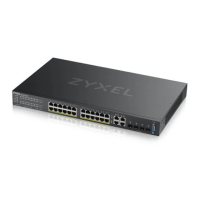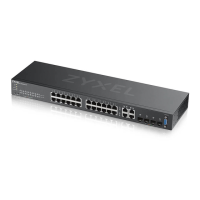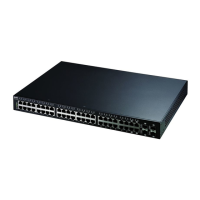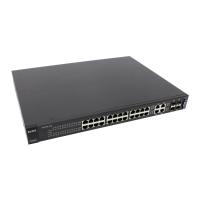Chapter 4 Web Configurator
GS2220 Series User’s Guide
72
PoE Setup For PoE models.
This link takes you to a screen where you can set priorities, PoE power-up settings and schedule
so that the Switch is able to reserve and allocate power to certain PDs.
Interface Setup This link takes you to a screen where you can configure settings for individual interface type
and ID.
IPv6 This link takes you to a screen where you can view IPv6 status and configure IPv6 settings.
Cloud
Management
This screen displays a link to a screen where you can enable or disable the Ne b ula C o ntro l
Ce nte r Disc o ve ry feature. If it is enabled, you can have the Switch search for the NCC (Nebula
Control Center). Another link takes you to the Ne b ula Switc h Re g istra tion screen which has a
QR code containing the Switch’s serial number and MAC address for handy registration of the
Switch at NCC.
Advanced Application
VLAN This link takes you to screens where you can configure port-based or 802.1Q VLAN (depending
on what you configured in the Switc h Se tup menu). You can also configure a voice VLAN, a
MAC based VLAN or a vendor ID based VLAN in these screens.
Static MAC
Forwarding
This link takes you to a screen where you can configure static MAC addresses for a port. These
static MAC addresses do not age out.
Static Multicast
Forwarding
This link takes you to a screen where you can configure static multicast MAC addresses for
ports. These static multicast MAC addresses do not age out.
Filtering This link takes you to a screen to set up filtering rules.
Spanning Tree
Protocol
This link takes you to screens where you can configure the RSTP to prevent network loops.
Bandwidth
Control
This link takes you to a screen where you can configure bandwidth limits on the Switch.
Broadcast Storm
Control
This link takes you to a screen to set up broadcast filters.
Mirroring This link takes you to screens where you can copy traffic from one port or ports to another port
in order that you can examine the traffic from the first port without interference.
Link Aggregation This link takes you to screens where you can logically aggregate physical links to form one
logical, higher-bandwidth link.
Port
Authentication
This link takes you to a screen where you can configure IEEE 802.1x port authentication as well
as MAC authentication for clients communicating through the Switch.
Port Security This link takes you to a screen where you can activate MAC address learning and set the
maximum number of MAC addresses to learn on a port.
Time Range This link takes you to a screen where you can define different schedules.
Classifier This link takes you to screens where you can configure the Switch to group packets based on
the specified criteria.
Policy Rule This link takes you to a screen where you can configure the Switch to perform special treatment
on the grouped packets.
Queuing Method This link takes you to a screen where you can configure queuing with associated queue
weights for each port.
Multicast This link takes you to screens where you can configure various multicast features and IGMP
snooping.
AAA This link takes you to a screen where you can configure authentication, authorization and
accounting services through external servers. The external servers should be RADIUS (Remote
Authentication Dial-In User Service).
IP Source Guard This link takes you to screens where you can configure filtering of unauthorized DHCP and ARP
packets in your network.
Table 18 Navigation Panel Links (Standard Mode) (continued)
LINK DESC RIPTIO N

